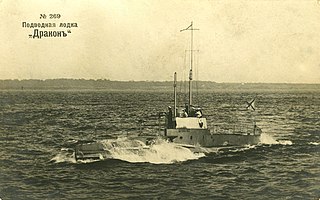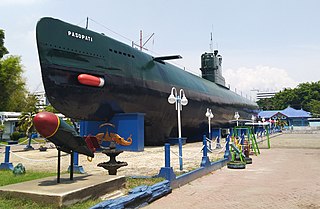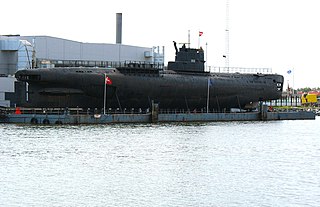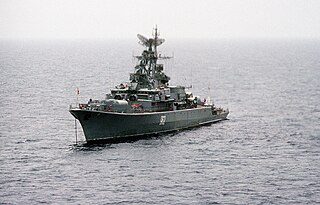
The Project 651, known in the West by its NATO reporting name Juliett class, was a class of Soviet diesel-electric submarines armed with cruise missiles. They were designed in the late 1950s to provide the Soviet Navy with a nuclear strike capability against targets along the east coast of the United States and enemy combatants. The head of the design team was Abram Samuilovich Kassatsier. They carried four nuclear-capable cruise missiles with a range of approximately 300 nautical miles (560 km), which could be launched while the submarine was surfaced and moving less than four knots (7.4 km/h). Once surfaced, the first missile could be launched in about five minutes; subsequent missiles would follow within about ten seconds each. Initially, the missiles were the inertially-guided P-5. When submarine-launched ballistic missiles rendered the P-5s obsolescent, they were replaced with the P-6 designed to attack aircraft carriers. A special 10 m2 target guidance radar was built into the forward edge of the sail structure, which opened by rotating. One boat was eventually fitted with the Kasatka satellite downlink for targeting information to support P-500 4K-80 "Bazalt" anti-ship cruise missiles. The Juliett class had a low magnetic signature austenitic steel double hull, covered by two inches (51 mm) thick black tiles made of sound-absorbing hard rubber.

Soviet submarine S-363 was a Soviet Navy Whiskey-class submarine of the Baltic Fleet, which became notable under the designation U137 when it ran aground on 27 October 1981 on the south coast of Sweden, approximately 10 km (6.2 mi) from Karlskrona, one of the largest Swedish naval bases. U137 was the unofficial Swedish name for the vessel, as the Soviets considered names of most of their submarines to be classified at the time and did not disclose them. The ensuing international incident is often referred to as the Whiskey on the rocks incident.

Whiskey-class submarines are a class of diesel-electric attack submarines that the Soviet Union built in the early Cold War period.

С-178 (S-178) was a Project 613B diesel submarine of the Soviet Navy. On October 21, 1981, in the Sea of Japan, the submarine under the command of Valery Marango was hit by a cargo ship. The collision killed 32 sailors.

S-80 was a diesel-electric submarine of the Soviet Navy.

The Soviet Navy's Project 611 were one of the first Soviet post-war attack submarines. They were roughly as capable as the American GUPPY fleet-boat conversions. They were a contemporary of the Whiskey-class submarines and shared a similar sonar arrangement. Like most conventional submarines designed 1946-1960, their design was influenced by the German Type XXI U-boat of the World War II era.

The Project 670 Skat submarine was a nuclear-powered cruise missile submarine built for the Soviet Navy and later operated by the Russian Navy. All Charlie I/II-class submarines are decommissioned. One Charlie-class submarine was used for testing an Oniks missile. Charlie I and its successor Charlie II-class submarines are designed by the Lazurit Central Design Bureau of Gorky.

Severnaya Verf is a major shipyard on Gutuevsky Island in Saint Petersburg, Russia, producing naval and civilian ships. It was founded as a branch of the Putilov Plant in the late 1800s. Under the Soviets, the shipyard was generally known as Shipyard No. 190 and reverted to its former name in 1989.

The Kaiman class were a class of submarines built for the Imperial Russian Navy before World War I. They were designed by Simon Lake and built at the W:m Crichton & C:o Okhta shipyard in Saint Petersburg. The boats had numerous defects resulting in a legal battle between Lake and the Russian Government. The boats were impounded in 1910 and rebuilding work took place to remedy some of the defects. The boats finally commissioned in 1911 and served in the Baltic Fleet.

Dostoynyy was a Project 1135 Burevestnik-class Large Anti-Submarine Ship or Krivak-class frigate. With an armament based around the Metel anti-submarine missile system, the vessel was commissioned on 31 December 1971 into the Northern Fleet of the Soviet Navy. The vessel took part in a number of exercises, including Okean-75, Sever-77 and Eskadra-84 and as far away as the Mediterranean Sea as part of the Soviet demonstration of their Naval reach. The ship was designated a Guard Ship from 28 July 1977 in response to a change in emphasis of the navy, and was upgraded between January 1985 and August 1988 with missiles that added anti-ship capability. After more than twenty years service, the ship was decommissioned on 30 June 1993.

KRI Pasopati (410) is a retired Project 613 Whiskey-class submarine of the Indonesian Navy.

ORP Bielik (295) was a Whiskey-class submarine of the Polish Navy during the Cold War. It was one of the four Whiskey-class submarines operated by the Polish Navy, the other three being ORP Orzeł (292), ORP Sokół (293) and ORP Kondor (294). The submarine was launched in the Soviet Union in 1955 where it served as S-279. In 1965 the ship entered Polish service where it served under the pennant number 295, and was active until 1988.

Soviet submarine B-80 was a Project 611 or Zulu-class conventional submarine of the Soviet Navy's Northern Fleet. She was in service during the Cold War, and after de-commissioning was sold in 1991 to private buyers in the Netherlands. She was scrapped in 2019.

Soviet submarine U-359 was a Soviet Whiskey-class submarine built in 1953 and in service until 1993. After decommissioning, it was acquired by a Danish project for unemployed youth interested in turning it into a cultural site and tourist attraction.

Grozyashchiy or Grozyashchy was a 1135M Burevestnik-class guard ship, or frigate with the NATO reporting name 'Krivak-II', that served with the Soviet and Russian Navies. Launched on 7 February 1977, the vessel operated as part of the Pacific Fleet as an anti-submarine vessel, with an armament built around the Metel Anti-Ship Complex. Grozyashchiy undertook a number of visits to nations friendly to the Soviet Union, including Angola, Mauritius, Mozambique and Sri Lanka. The ship also formed part of the Soviet presence during the Sino-Vietnamese conflicts and visited Da Nang, Vietnam, in the October 1981. With the dissolution of the Soviet Union, Grozyashchiy joined the Russian fleet, but lack of funding meant that a planned repair in 1992 was not completed and instead the vessel was decommissioned on 13 February 1995 and sold to be broken up.

Revnostnyy was a Project 1135M Burevestnik-class Guard Ship or 'Krivak' class frigate that served with the Soviet Navy. Launched on 23 April 1980, the vessel operated as part of the Pacific Fleet as an anti-submarine vessel, with an armament built around the Metel Anti-Ship Complex. Revnostnyy patrolled extensively as far afield as the Arabian Peninsula and Sea of Japan. The ship undertook a friendly visit to India in 1984 and, during the following year, formed part of the escort for a flotilla led by the Soviet aircraft carrier Novorossiysk which helped develop Soviet tactics for carrier-borne aircraft. Taken out of service for an overhaul in 1988, Revnostnyy was instead placed in reserve until 24 July 2003, when the ship was decommissioned and sold to be broken up.

Gromkiy was a Project 1135M Burevestnik-class Guard Ship or 'Krivak II'-class frigate that served with the Soviet and Russian Navies. Launched on 11 April 1978, the vessel operated as part of the Northern Fleet as an anti-submarine vessel, with an armament built around the URPK-5 Rastrub missile system. In 1991, the ship took part in the semicentennial commemoration of the first of the arctic convoys of the Second World War alongside the Royal Navy frigate HMS London. Soon afterwards, the ship was transferred to the Russian Navy following the dissolution of the Soviet Union. Gromkiy served for less than two years in this new role before being withdrawn for repairs and, ultimately, decommissioning on 16 March 1998.

Rezvyy or Rezvy was the lead Project 1135M Burevestnik-class Guard Ship or 'Krivak II'-class frigate. Launched on 30 May 1975, the vessel was designed to operate in an anti-submarine role in the Soviet Navy, with armament built around the Metel Anti-Ship Complex. Part of the Northern Fleet, the vessel undertook operations in the Atlantic Ocean, including visits to Congo and Cuba, and participating in the Atlantic-84 major naval exercise in 1984. After a major refit between 1989 and 1992, Rezvyy was recommissioned into the Russian Navy. The ship continued to travel, visiting Norway in 1993. After more than twenty-five years service, Rezvyy was decommissioned on 1 June 2001 and subsequently broken up.

Neukrotimyy was a Project 1135M Burevestnik-class Guard Ship or 'Krivak II'-class frigate that served with the Soviet and Russian Navies. The vessel was known as Komsomolets Litvyy between 1987 and 1990. Launched on 17 September 1977, Neukrotimyy was designed to operate as an anti-submarine vessel with the Baltic Fleet, using an armament built around the Metel Anti-Ship Complex. The vessel undertook many visits to other countries outside the Soviet Unions, including Angola, East Germany, Nigeria and Poland. Following the dissolution of the Soviet Union, in 1991, the ship was transferred to the Russian Navy and continued to travel to countries like the Netherlands. Despite being accidentally holed in 2005 and being badly burnt in a fire in 2008, Neukrotimyy remained the penultimate of the class to remain in service, finally being decommissioned on 29 June 2009.

Bessmennyy was a Project 1135M Burevestnik-class Guard Ship or 'Krivak II'-class frigate that served with the Soviet and Russian Navies. The vessel was the seventh of the class to enter service. Launched on 17 September 1977, Bessmennyy was designed to operate as an anti-submarine vessel with the Northern Fleet, using an armament built around the Metel Anti-Ship Complex. Following the dissolution of the Soviet Union, in 1991, the ship was transferred to the Russian Navy and took part in a pioneering visit to Gibraltar two years later, the first time that Russian warships had visited the territory in living memory. Bessmennyy was retired on 16 March 1998, disarmed and subsequently broken up.




















